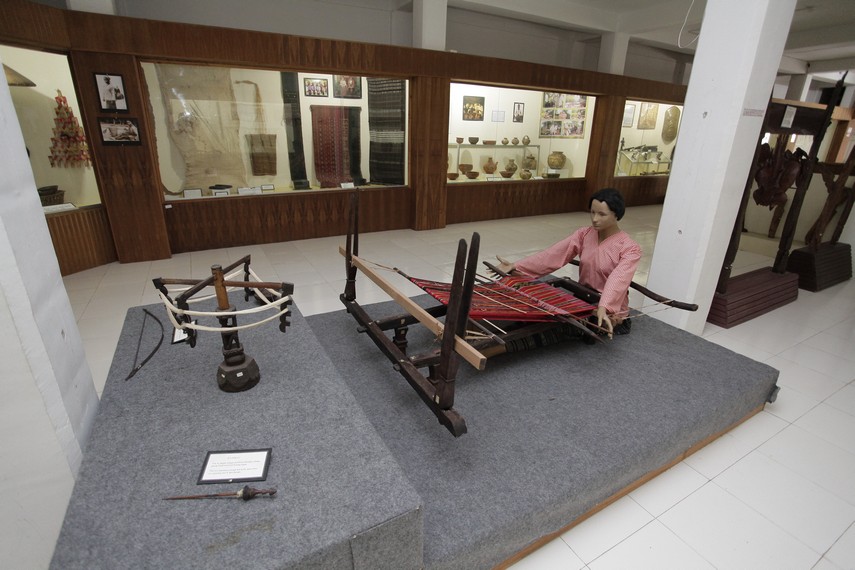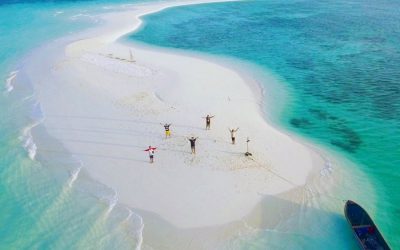Home / Batik Regions – Eastern Indonesia – Maluku / Siwalima Museum
Cultural Destination
Embrace the spirit of the place!
Siwalima Museum
Siwalima Textile Museum (Photo:Indonesia Kaya)
Siwalima Museum
The word “Siwalima” is composed of two words which have been taken from the history of the kingdoms which once developed in Maluku. “Siwa” makes reference to nine kingdoms formed in south Maluku and “lima” refers to the five ones in the northern part of the province. In Siwalima museum there are two buildings that showcase Maluku’s culture.
Cultural Tourism Destination
Siwalima Museum
Tourist Attractions in Maluku
Kei Islands
One of the most famous destinations here is the Ngurtafur white beach, located on
Hukurila Undewater Cave
This underwater cave stores the greatest landscape of
Maluku
Batik Motifs
Pattimura
Pattimura is the name of an Indonesian hero who fought against colonialism in
Pala Salawaku
This motif illustrates the unique weapons of the Maluku region, namely
Tifa Totobuang
The batik motifs illustrate Maluku’s traditional music instrument called
Discover
Indonesian
Batik
Motifs
Angsa Duo
According to legend, the Angso duo batik motif is a pair of swans that are believed to have led Princess
La Galigo
La Galigo is a literary work of the Buginese Epic that has 300 thousand epic lines. It is considered even
Gedhog Kembang Waluh
a combination of Javanese cultural motif of the Majapahit kingdom (XII-XIV century) with
Manguni Minahasa
Manguni is identified as the symbol of the Minahasa people. Manguni is known as a
Parang Seling
Parang Seling or “alternating daggers” is a royal batik motif. It is a feminine variant of
Wakatobi
It symbolizes the coastal beauty of the Wakatobi island and the symbol of Patra symbolizes
Pattimura
Pattimura is the name of an Indonesian hero who fought against colonialism in
Gumin Tambun
Based on Hindu mythology, this motif symbolizes lucks, abundant wealth, and
Biji Kopi
The coffee seeds motif illustrates the pride of local coffee specialities in
Sekar Jati
Sekar means flower and Jati refers to teak trees that symbolizes a strong mental character that
Gonggong Siput
Gonggong (Strombus Turturella) is one type of sea snail found around
Buketan Bali
The Balinese bouquet (Buketan Bali) is a floral arrangement and the name is
Mahkota Siger
Siger is the crown of a noblewoman in ancient time. It is a symbol of femininity, strength, and
Singayaksa
The Singayaksa motif comes from the name of a place where Sultan Hasanuddin used to
Taiganja
Taiganja is a precious gold pendant that shows the social status of the Kaili family. It is
Keluak Daun Pakis
The word “Keluak” is a Minang language which means twisted or tangled. The Motif of
Tampuk Manggis Sasirangan
The motif illustrates the philosophy of the mangosteen fruit, which is
Gurdo Solo
Gurdo or garuda bird is the mount of the Indian god Vishnu. As the Sun Bird,
Gajah Way Kambas
The motif illustrates the Lampung’s natural reserve, the Way Kambas. it also symbolizes
Pinawetengan
The Pinawetengan Batik pattern was taken from a prehistoric inscription in
Lipaq Sabe
Lipaq Saqbe contains a simple geometric classical motif with various flower decorations. This textile is
Pala Salawaku
This motif illustrates the unique weapons of the Maluku region, namely
Malinau Cultural Festival
You will witness a unique competition that might not be found other than in
Tubo Kelapa
Coconut tree is a symbol of a good character and strong mentality. It illustrates the more success a person, the more
Karawo Mahkuta
Mahkuta refers to Gorontalo’s traditional crown. It represents noble characters of
Tabir Tanjung
Tanjung flower is a type of Cherry tree flower, which is commonly found in
Wirasat
Wirasat or divine inspiration is a gift from God. This inspiration is symbolized by
Burung Bidadari
Bidadari birds are endemic birds in Halmahera. This motif represents an
Enggang Dayak
Local people beliefs that hornbills are an incarnation of the Commander of the Birds. It has supernatural
Leuit Sijimat
This motif reflects the daily activities of the Baduy tribe in Banten. The main ornaments of batik motif consist of:
Bultiya
The word ‘Bultiya’ is an acronym of the three major tribes in North Kalimantan, namely
Lontara
The Lontara script itself is a typical ancient script of Bugis and Makassar communities. History records that
Teguh Bersatu
This batik motif shows the strength of the people of Kupang. It also represents a sense of
Sandeq
Sandeq Boat is a symbol of the maritime importance of the West Sulawesi region. The greatness of
Jupri Kembang Teh
Kembang Teh illustrates the tendrils of tea plants that grow in the highlands of
Bomba Mawar
This motif means sacred love for family, kingdom, and God; It also illustrates
Desa Na Tolu
The Desa Na Tolu characteristic pattern symbolizes the Batak philosophy of existence and
Daun Lada Hitam
The black pepper motif represents the main commodity of Bangka Belitung
Tengkawang Ampiek
With its many advantages, the Dayaks use this leaf in ritual ceremonies. This plant is a symbol of
Rangkiang
The word “Rangkiang” refers to the rice granary in the Minangkabau language. It symbolizes
Pohon Hayat (Tree of Life)
The Batik motifs in Lampung are dominated by the acculturation of Buddhist and
Prada Papua
The word “Prada” in the Javanese-Indonesian dialect means a batik textile that
Tangerang Herang
Tangerang Herang motif is a symbol of Tangerang city. The Tangerang Herang batik motif consists of
Tikar Natuna
The Tikar Natuna motif is adapted from the traditional making of pandanus mats in
Honai
The Honai is inspired by the traditional house of the Papuan community living in
Tongkonan
Toraja’s traditional house is called Tongkonan. Tongkonan is a place for
Pati-Pati Pinehiku
It symbolizes the hierarchy in society and the social status of the Mekongga
Dayak Taghol
Dayak Taghol has a distinctive style of four curved lines and small dots. This motif represents
Ukir Sentani
The Ukir motif is a batik motif that is inspired by various traditional Sentani wood carvings
Daun Simpor
This motif is inspired by the Simpor plant (Dillenia Suffruticosa) which is a typical
Karawo Pinang
Pinang refers to the Palm areca tree. This motif is considered as the original
Jumputan Bintang
The word Jumputan means the tie-dye technique, while the word “Bintang” refers to
Tanah Liek
The word “Tanah Liek” refers to clay in Minang language. It is also known as
Dayak Kamang
Kamang motif is generally found in the Dayak tribe shield because it is believed to
Gigi Haruan Lidi
The Gigi Haruan Lidi motif is taken from the name of the cork fish and is a symbol of
Kaharingan
The Kaharingan or ‘tree of life’ based on the Dayak tribes’ belief system. This tree symbolizes
Gonggong Beruntun
This motif illustrates that a person should maintain a positive attitude and
Raja Ampat
Raja Ampat motif represents the marine life at Raja Ampat archipelago in
Kasih Tak Sampai
‘Kasih Tak Sampai’ is an idiom in the Indonesian language which refers to
Besurek Rafflesia
The term “Basurek” refers to a textile that contains letters or inscriptions
Ake Patra
Ake is related to the divinity and the composition of the universe. It is a symbol of
Gorga Simeol-Meol
The Gorga Simeol-meol is a pattern of plant tendrils. it is regarded as a symbol of longevity and
Gamolan
This motif illustrates Gamolan, a bamboo musical instrument of Lampung that is
Parang Rusak
Another meaning behind this motif is an unconquerable spirit, symbolized by
Tenun Bima
The motifs are adopted from Bima woven textile. This pattern has received a great
Kain Cual
Cual textile tradition has existed since the 17th century. The word “Cual” refers to
Paqbarre Allo
The word “Barre” means round and “Allo” means the sunlight. This motif is interpreted as
Tifa Totobuang
The batik motifs illustrate Maluku’s traditional music instrument called
Bintik Tujuh
The Bintik Tujuh (Seven Dots) motif has 7 white spots and green color gradation as
Hiu Taliyasan
Indonesia is also home to the world’s largest fish, the whale shark (Rhincodon typus). Hiu Taliyasan refers to
Gentala Arasy
Built as high as 80 meters, the tower also highlights the historical side of
Durian Pecah
Broken Durian motifs depict the foundation of faith. The second half signifies the mastery of
Bekantan Pakis
This motif represents Pakis Haji (Polystichum setiferum), an endemic plant in



